Opinion
Frank Stella at the Whitney Is All Style, No Substance
These days Stella’s wheeling stripes and shaped canvasses remind viewers of corporate lobbies.
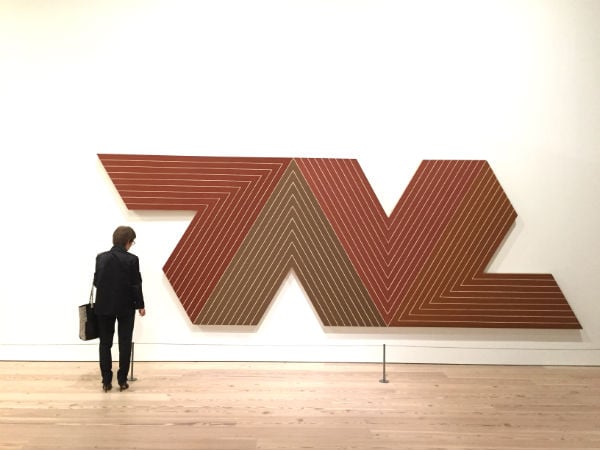
Image: Ben Davis.
These days Stella’s wheeling stripes and shaped canvasses remind viewers of corporate lobbies.

Ben Davis

Some 58 years ago, Frank Stella graduated from Princeton University and almost immediately landed a career of art stardom, one that has lasted up to this minute with his major new retrospective at the Whitney Museum of American Art.
In today’s youth-oriented art world, Stella’s speedy ascent likely doesn’t stand out. But in the late ’50s it was rare, very rare. Artists of the Abstract Expressionist generation usually had a body of work and some life experience behind them before they even imagined major commercial success. Mark Rothko and Jackson Pollock were both past 30 when they had their first solo shows; Barnett Newman and Willem de Kooning were in their mid-40s.
The whole present-day art-school to art-career trajectory hadn’t yet been assembled, but Stella was probably one of the first whose life fit the pattern. At Phillips Academy, Stella had the best exposure to recent art that any teenager could have hoped for in the Eisenhower era; at Princeton, he lucked into a three-person clique with fellow painter Darby Bannard and the art historian Michael Fried, who would go on to be one of the most important critics of the ’60s.
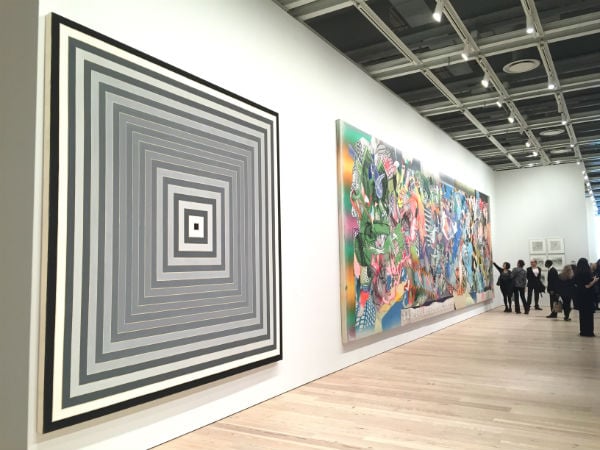
Entrance to “Frank Stella: A Retrospective” at the Whitney Museum of American Art.
Image: Ben Davis.
Inundated as we are today with retro-formal art-school painting, the Whitney survey (curated by Museum of Fort Worth curator Michael Auping and Whitney chief Adam Weinberg) makes me think of how much Stella’s style reflects this particular hermetic social background. It explains why I can admire the work’s smarts while feeling basically removed from it. The pleasures offered by the Whitney’s tour of Frank Stella’s many career breakthroughs feel less like the existential drama of the classic tortured artist and more like watching someone solve a Rubik’s Cube.
At Princeton, Stella took his BA in History, writing a thesis on the political context of medieval manuscripts. Still, his principal interest was studio art, and he later remembered diverting his thesis into a long aesthetic aside, theorizing “how decoration becomes art and when it ceases to be just decoration.” The argument hinged on a comparison of Jackson Pollock and Celtic knotwork: “One happened to be painting and one was manuscript illumination, but they both reached the category of art and left the lower category of simple repetitive design or pedestrian decoration far behind.”
Thus, Stella was always notably more interested in problems of form than social content. His thesis, it would seem, theorized Pollock’s Abstract Expressionism as the superhero version of decoration; the beatnik angst that had been part of Pollock’s reception in, say, Harold Rosenberg’s 1952 description of it as “Action Painting,” was of no interest.
As Stella was graduating from Princeton, the cozy New York art scene was beginning its long maturation into the professionalized “art world” we know today. One harbinger of this was the 28-year-old Jasper Johns’s show at Castelli Gallery in 1958, which caused a sensation and sold out, a then almost-unheard-of feat. This coup couldn’t help make an impression on the young Stella, who was nothing if not ambitious.
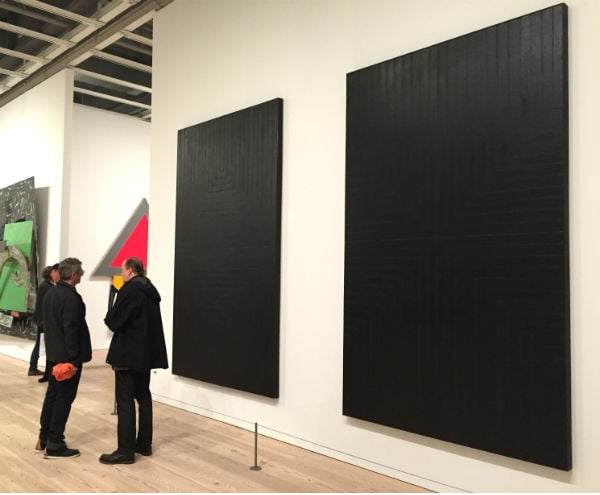
Installation view of two “Black Paintings” at the Whitney Museum of American Art.
Image: Ben Davis.
The innovation of Stella’s career-making “Black Paintings” of 1959 was the notion of “deductive structure” (the term is Michael Fried’s, Stella’s Princeton buddy turned champion). The idea was that the entire content of the painting could be derived from the dimensions of the canvas itself, starting with the edge and dividing the surface into a number of equal, rhythmic bars.
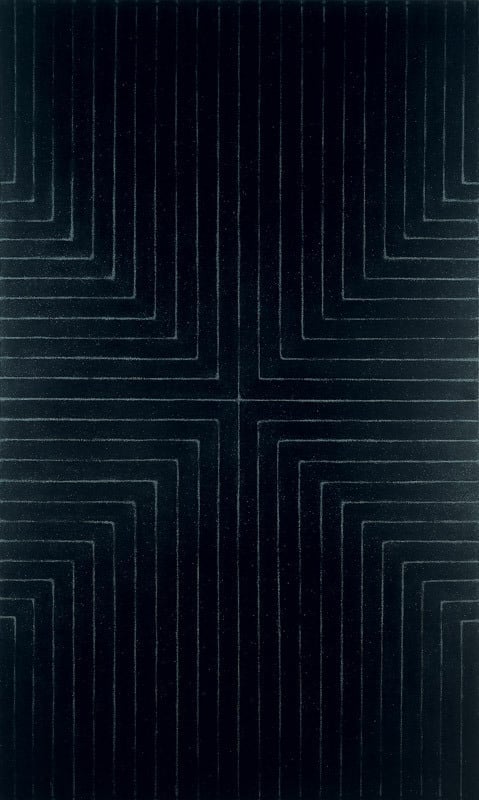
Frank Stella, Die Fahne hoch! (1959).
Image: Courtesy Whitney Museum of American Art.
Part of what made Johns’s American flag paintings so explosive was the way they derived content and structure from the deadpan citation of their subject, neutralizing the overbearing rhetoric of subjectivity around Abstract Expressionism at the time. Stella’s “Black Paintings” found a way to keep the visual language and scale of American abstract art while incorporating the hollowed-out, proto-pop cool of Johns, too.
It was a great formula and an immediate hit. Stella won a place in New York’s Museum of Modern Art showcase in 1959, at the ripe old age of 23. At the opening, Margaret Scolari Barr, wife of museum director Alfred Barr, praised the ambitious young artist but seemed, as far as he was concerned, to be fretting a little too much about what impact early success would have on him. He bridled. Content-wise, his subsequent career peregrinations seem mainly to be “about” proving—successfully, more often than not—that his big idea wasn’t just a youthful gimmick, but had flexibility to grow.
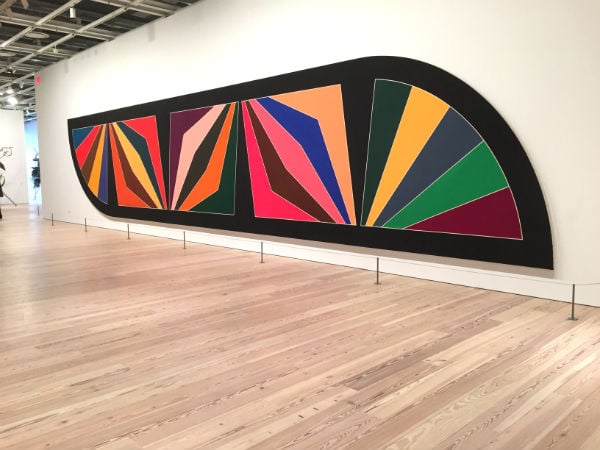
Installation view of Frank Stella, Damascus Gate (Stretch Variation III) (1970) at the Whitney Museum of American Art.
Image: Ben Davis.
In the process he became the maestro of the shaped canvas, expanding the spatial potentialities of painting. The stripes of the “Black Paintings” broke free into dynamic zig-zags and chevrons that hung on the wall; then later, blossomed into immense, runway-sized paintings inspired by the shape of protractors, filled in with vibrating blocks of color; then gave birth to complicated reliefs that were constructed, not painted; and finally, starting in the 1980s, inflated into wall-filling sculptural concoctions made of multicolored metal planes, glitter-covered struts, and groovy interlocking cut-out forms, ultimately with the help of computers and industrial fabrication.
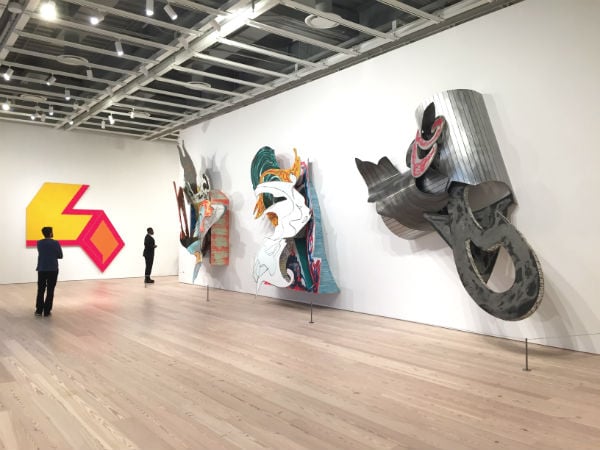
Works from Frank Stella’s “Moby Dick” series, late ’80s at the Whitney Museum of American Art.
Image: Ben Davis.
Pioneering though they were, these days Stella’s wheeling stripes and shaped canvasses remind viewers of corporate lobbies, because that is where many of them ended up. Perhaps judging him on this account is unfair. But it’s worth recalling that, back in 1959—the same year Stella was making his “Black Painting” breakthrough—Rothko legendarily backed out of a lavish commission for the Four Seasons, exactly because he feared that the setting would neutralize the humanity and power of his work, rendering it as décor.
Stella’s own preemptively neutralizing temperament never allowed his art to make any promises that would serve as a similar brake. The New York Times would in the 1980s describe him as the “developer’s choice.”
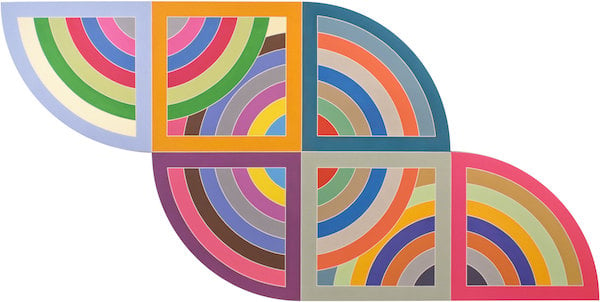
Frank Stella, Harran II (1967).
Image: Courtesy Solomon R. Guggenheim Museum © 2015 Frank Stella/Artists Rights Society.
And yet, a hovering insecurity that his work might well be too detached, too anomic, has haunted every stage. This intimation, I think, is behind Stella’s odd titles. They redound with exotic literary references and spicy political intimations (the names of Arab philosophers, Polish synagogues, chapters of Moby Dick), tempting the viewer with the promise of some secret buried extra-formal drama that is, for the most part, not there.
In 1984, still not yet 50 but invited to share his career wisdom at Harvard University, Stella caused a stir by essentially admitting this very fact, declaring that abstract painting had become too cipher-like to communicate on a human level with a wide audience. This public about-face provided the manifesto for his final turn from his ultra-lucid, “deductive” proto-minimalism to his later self-described “Maximalism,” characterized by freakish, irrational, baroque elaboration.
Critics don’t much like the swollen theatrics of Stella’s late work. I share the judgment though appreciate how wacky they are. The only thing I’d add is that, I think art critics don’t like them because by and large critics don’t like the industrial-strength distraction factory that the art world has become. The late ’70s had seen museums shed their above-it-all image to court bigger audiences via fine-art “blockbuster” shows. Stella, always a creature of the art world and laser-focused on making painting that felt “contemporary,” tacked to the shifting winds, from airy elitism to savvy spectacle, right on time.

Frank Stella, Plant City (1963).
Image: Courtesy Philadelphia Museum of Art © 2015 Frank Stella/Artists Rights Society.
The Whitney show contains quite a lot of these late monsters. Does it make a case for them? Yes, in the very specific sense that in scale and effect they are the kinds of bulky works that only its roomy, beautiful, tourist-hungry new building could host. For the casual art viewer coming down the High Line to the Whitney, it may well be that the early Plant City, a tan, striped canvas in the shape of an eight-pointed star, is less memorable than a bonkers, unbalanced late piece like La Pena de Hu. The former has an austere elegance; the latter looks like Vladimir Tatlin got drunk on Four Loko and went on an AutoCAD bender.
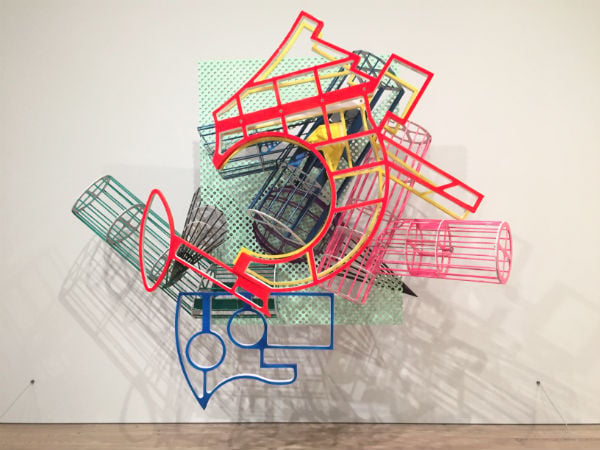
Frank Stella, La Pena de Hu (1987–2009) at the Whitney Museum of American Art.
Image: Ben Davis.
In that long-ago Princeton theses on Pollock and Celtic ornament, Stella claimed that the formula for “art” was pushing decoration to the point where it transcended itself. The knotted pyrotechnics of these final pieces certainly do that—it’s actually hard to think of a space where they would work as passive décor. It’s just that the direction they transcend decoration towards is the domain of theme parks and Broadway bombast. That is, spectacles built not to savor but to stun, not for connoisseurs but for visitors passing through.
“Frank Stella: A Retrospective” is on view at the Whitney Museum of American Art through February 7, 2015.